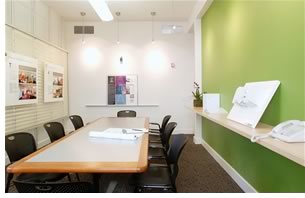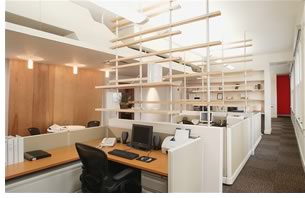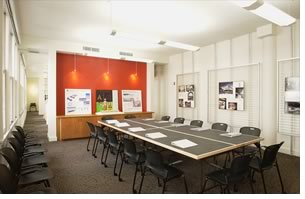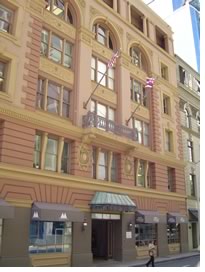

09/2004
AIA Honolulu is the first to achieve Gold LEED-CI in Hawaii
AIA Honolulu has attained great bragging rights. The chapter’s new office was recently awarded Gold certification from the U.S. Green Building Council’s Leadership in Energy and Environmental Design for Commercial Interiors (LEED-CI™). A participant in the LEED-CI pilot program to establish criteria and a rating system for sustainable interior spaces, AIA Honolulu’s office is one of only 10 certified LEED-CI projects in the nation.
According to Joe Ferraro, AIA, principal of Ferraro Choi and Associates Ltd. (FCA), the process was member-driven and collaborative from the outset. AIA Honolulu’s Committee on the Environment (COTE) recommended that the chapter register for the LEED-CI pilot program and prepared the application. FCA prepared the project’s registration and documentation and worked closely with the COTE, chapter members, board, and staff to ensure a facility that responded to all needs.
 Chapter member volunteers, local vendors, and affiliate members spent
many hours volunteering in deconstruction, demolition, prepping, painting,
and providing tremendous support in supplying supplies and materials,
making the project a reality,” Ferraro enthused.
Chapter member volunteers, local vendors, and affiliate members spent
many hours volunteering in deconstruction, demolition, prepping, painting,
and providing tremendous support in supplying supplies and materials,
making the project a reality,” Ferraro enthused.
 The new offices are located in Honolulu’s historic Stangenwald
Building, designed by Charles W. Dickey, one of the chapter’s founding
members. At six stories tall and 100 years old, the Stangenwald dominated
Honolulu’s skyline until the first skyscraper was built in the early
1960s. Although still considered a prime address, changes were imposed
on the structure over time that rendered it less friendly to workers and
the environment. FCA remedied those modifications by removing the dropped
ceiling; replacing archaic wiring and lighting fixtures; and renovating
the windows to restore their operability, let in natural light, and encourage
cross-ventilation. Approximately three-quarters of the materials removed
during renovation were either recycled or composted. New materials contain
low VOCs, improving the indoor air quality and reducing health risks.
The new offices are located in Honolulu’s historic Stangenwald
Building, designed by Charles W. Dickey, one of the chapter’s founding
members. At six stories tall and 100 years old, the Stangenwald dominated
Honolulu’s skyline until the first skyscraper was built in the early
1960s. Although still considered a prime address, changes were imposed
on the structure over time that rendered it less friendly to workers and
the environment. FCA remedied those modifications by removing the dropped
ceiling; replacing archaic wiring and lighting fixtures; and renovating
the windows to restore their operability, let in natural light, and encourage
cross-ventilation. Approximately three-quarters of the materials removed
during renovation were either recycled or composted. New materials contain
low VOCs, improving the indoor air quality and reducing health risks.
 LEED-CI
is the newest green-design tool from the USGBC. Recognizing the need
for sustainability standards for interior spaces, the USGBC created
a pilot program for tenant spaces in office and institutional structures.
LEED-CI was designed to complement LEED for Core & Shell (LEED-CS),
currently under development. According to Ferraro, “the LEED-CI
process is very helpful in that it is structured and user-friendly
for professionals. However, since LEED is ever-evolving, at times
it was very trying and demanding. There are a lot of details, statistics,
and documentation required to evaluate and rate the project and process.” Nevertheless,
he notes, “the most rewarding part is seeing the results of
the process and what the owner-designer-contractor-vendor team have
accomplished.”
LEED-CI
is the newest green-design tool from the USGBC. Recognizing the need
for sustainability standards for interior spaces, the USGBC created
a pilot program for tenant spaces in office and institutional structures.
LEED-CI was designed to complement LEED for Core & Shell (LEED-CS),
currently under development. According to Ferraro, “the LEED-CI
process is very helpful in that it is structured and user-friendly
for professionals. However, since LEED is ever-evolving, at times
it was very trying and demanding. There are a lot of details, statistics,
and documentation required to evaluate and rate the project and process.” Nevertheless,
he notes, “the most rewarding part is seeing the results of
the process and what the owner-designer-contractor-vendor team have
accomplished.”
Copyright 2004 The American Institute of Architects.
All rights reserved. Home Page ![]()
![]()
 |
||
| For more
information on LEED-CI, visit the USGBC Web site. Photos © David Franzen
|
||
